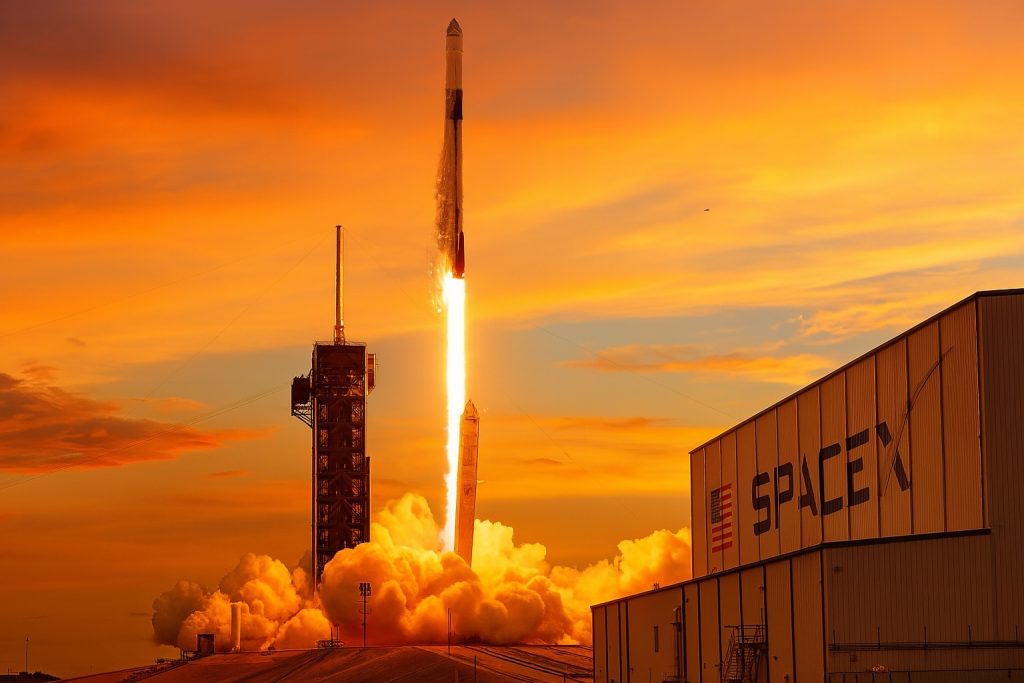- Space Coast launches set records with 93 launches in 2024 and up to 156 projected for 2025, driven by SpaceX, ULA, and Blue Origin.
- SpaceX’s Starlink megaconstellation has surpassed 7,900 satellites in orbit.
- Two Falcon 9 missions deployed 53 Starlink satellites within 13 hours, marking SpaceX’s 81st launch of 2025 and the 468th booster recovery.
- Amazon’s Project Kuiper has 54 satellites in orbit toward a planned 3,200-satellite constellation, with AWS data processing integration.
- Japan’s H-2A rocket completed its 50th and final mission, deploying the greenhouse gas monitoring satellite GOSAT-GW, as the H3 rocket begins to replace H-2A.
- The Vera C. Rubin Observatory released its first images from the 3.2-gigapixel LSST camera, with expectations to discover about 20 billion galaxies.
- NASA’s James Webb Space Telescope directly imaged exoplanet TWA 7b, orbiting a nearby young star about 111 light-years from Earth.
- The Hubble Space Telescope captured an active galactic center in spiral galaxy UGC 11397 powered by a 174-million-solar-mass supermassive black hole, about 250 million light-years away.
- Indian astronaut Shubhanshu Shukla became the first Indian to reach the International Space Station on the Axiom-4 mission and spoke with Prime Minister Modi from orbit.
- The Pentagon contracted SpaceX to deploy 500 military satellites in a laser-linked network for secure global communications and missile tracking.
Space News Digest: June 2025
An In-Depth Analysis of the Latest Breakthroughs, Launches, and Discoveries in the Global Space SectorTable of Contents
1. Space Coast Launches: Breaking Records and Shaping the Future 2. Satellite Mega-Constellations: Starlink, Kuiper, and the New Race for Orbit 3. Japan’s H-2A Rocket Retires: A New Era with H3 4. Astronomy Frontiers: Rubin Observatory, JWST, and Hubble 5. Exoplanet Discoveries: Microlensing and Direct Imaging 6. Space Debris and Satellite Security 7. Human Spaceflight: India’s Historic ISS Mission 8. Climate and Earth Observation: Satellites for a Changing Planet 9. Celestial Events: Conjunctions, Meteors, and Cosmic Phenomena 10. Policy, Security, and the New Space Race 11. Outlook: The Next Chapter in Space ExplorationSpace Coast Launches: Breaking Records and Shaping the Future
The Space Coast, centered around Cape Canaveral and Kennedy Space Center in Florida, continues its meteoric rise as the world’s premier launch hub. In 2024, the region shattered its previous record with 93 launches, and projections for 2025 suggest an astonishing 156 launches could take place, underscoring the exponential growth of commercial and governmental space activity.Key Players and Missions
- SpaceX: Continues to dominate with its Falcon 9 and Falcon Heavy vehicles, supporting Starlink deployments, ISS resupply, and crewed missions.
- United Launch Alliance (ULA): Maintains a steady cadence with Atlas V and Vulcan launches, supporting both commercial and national security payloads.
- Blue Origin: Expanding its presence with New Glenn, targeting both commercial and government contracts.
Notable Trends
- Human Spaceflight: Regular crewed missions to the ISS and commercial space stations.
- Advanced Satellite Deployments: Increasingly sophisticated payloads, including climate monitoring, defense, and broadband constellations.
- International Collaboration: NASA, ESA, and private partners are leveraging the Space Coast’s infrastructure for global missions.
[1]Recap:
– 93 launches in 2024
– Up to 156 launches projected for 2025
– Major players: SpaceX, ULA, Blue Origin
– Focus: Human spaceflight, advanced satellites, international partnerships
Satellite Mega-Constellations: Starlink, Kuiper, and the New Race for Orbit
The satellite broadband race is intensifying, with SpaceX’s Starlink and Amazon’s Project Kuiper leading the charge. These mega-constellations are reshaping global connectivity and driving unprecedented launch cadences.SpaceX Starlink: Relentless Expansion
- Recent Launches:
- 27 Starlink satellites launched from Cape Canaveral, marking the Falcon 9’s 20th flight for this booster and the 468th booster recovery.
- Dual Falcon 9 missions deployed 53 Starlink satellites from both Florida and California within 13 hours, pushing the constellation past 7,900 satellites.
- 26 Starlink satellites launched from Vandenberg SFB, marking SpaceX’s 81st launch of 2025.
- Military Applications:
- The Pentagon has contracted SpaceX to deploy 500 military satellites for secure, laser-linked communications and missile tracking, forming a nearly invulnerable network.
Amazon Project Kuiper: The Challenger Rises
- Second Batch Launched:
- 54 Kuiper satellites now in orbit, aiming for a 3,200-satellite constellation to rival Starlink.
- Project Kuiper leverages AWS for advanced data processing and could replace Australia’s NBN satellites.
China’s Ambitious Satellite Plans
- MWC Shanghai 2025:
- China plans 38,000 satellites across three constellations, focusing on satellite-terrestrial convergence for IoT, enterprise, and remote coverage.
Direct-to-Device (D2D) Revolution
- AST SpaceMobile and Starlink are pioneering direct satellite-to-smartphone connectivity, with commercial launches in Japan and regulatory discussions ongoing in Europe.
Recap:
– Starlink: 7,900+ satellites, rapid launch cadence, military contracts
– Kuiper: 54 satellites, 3,200 planned, AWS integration
– China: 38,000 satellites planned
– D2D: Direct satellite-to-phone services emerging globally
Japan’s H-2A Rocket Retires: A New Era with H3
After 24 years and 50 successful missions, Japan’s H-2A rocket has completed its final launch, deploying the GOSAT-GW climate monitoring satellite. This marks the end of an era and the beginning of a new chapter with the H3 rocket, designed for cost-competitiveness and increased launch cadence.H-2A’s Legacy
- 50 launches since 2001, deploying satellites for climate monitoring, navigation, and planetary exploration.
- Final mission: Launched GOSAT-GW to monitor greenhouse gases and water cycles, supporting global climate research.
The H3 Rocket
- Developed by Mitsubishi Heavy Industries and JAXA.
- Aims to reduce launch costs and boost Japan’s competitiveness in the global satellite launch market.
[10] | [11] | [12] | [13] | [14]Recap:
– H-2A: 24-year legacy, 50 launches
– Final payload: GOSAT-GW climate satellite
– H3: Next-generation, cost-effective, higher cadence
Astronomy Frontiers: Rubin Observatory, JWST, and Hubble
Vera C. Rubin Observatory: A New Eye on the Universe
- First Images Released:
- The 3.2-gigapixel LSST camera, the world’s largest digital camera, captured its first astro images, promising to revolutionize sky surveys and asteroid detection.
- The observatory is expected to discover 20 billion new galaxies and increase known solar system objects tenfold.
- Budget Concerns:
- NSF budget cuts threaten future operations and U.S. leadership in ground-based astronomy.
James Webb Space Telescope (JWST): Unveiling Cosmic Origins
- Galaxy Disk Evolution:
- JWST resolved thick and thin disk structures in 111 galaxies, confirming that thick disks form first, followed by thin disks, with timing dependent on galaxy mass.
- Direct Imaging of Exoplanets:
- JWST directly imaged TWA 7b, the lightest planet ever imaged with this technique, orbiting a nearby young star.
Hubble Space Telescope: Peering into Galactic Hearts
- UGC 11397:
- Hubble imaged the spiral galaxy UGC 11397, revealing an active galactic center powered by a supermassive black hole, shrouded in dust but emitting powerful X-rays.
- Andromeda Galaxy Composite:
- NASA released an unprecedented composite image of Andromeda, combining data from over a dozen telescopes, revealing new structural and evolutionary details.
Recap:
– Rubin Observatory: First images, 3.2-gigapixel camera, 20B galaxies expected
– JWST: Galaxy disk evolution, direct exoplanet imaging
– Hubble: Active galactic nuclei, Andromeda composite
Exoplanet Discoveries: Microlensing and Direct Imaging
Gravitational Microlensing: Einstein’s Theory in Action
- AT2021uey b:
- Discovered on the outskirts of the Milky Way, this Jupiter-sized exoplanet orbits an M dwarf star, only the third such planet found so far from the Galactic bulge.
- Technique:
- Gravitational microlensing, predicted by Einstein’s general relativity, magnifies a star’s light due to space-time warping, enabling detection of distant, otherwise invisible planets.
Direct Imaging: JWST’s Breakthrough
- TWA 7b:
- The James Webb Space Telescope’s first direct image of an exoplanet, TWA 7b, orbiting a nearby young star, marks a milestone in planet formation studies.
Recap:
– Gravitational microlensing reveals rare, distant exoplanets
– JWST achieves direct imaging of a young exoplanet
Space Debris and Satellite Security
Mysterious Signals from Defunct Satellites
- NASA Relay 2:
- A 60-year-old, decommissioned satellite emitted a mysterious radio signal, likely from electrostatic discharge, raising concerns about interference with astronomical instruments and the growing risks of space debris.
Legal and Environmental Concerns
- SpaceX Starship Debris:
- Mexico is considering legal action against SpaceX after Starship debris landed in Tamaulipas, citing environmental contamination and possible international law violations.
Security and Resilience
- Pentagon-SpaceX Partnership:
- Deployment of 500 military satellites to secure global communications and missile tracking, emphasizing the strategic importance of resilient space infrastructure.
Recap:
– Space debris can cause unexpected signals and hazards
– Legal, environmental, and security implications are growing
Human Spaceflight: India’s Historic ISS Mission
Shubhanshu Shukla: First Indian on the ISS
- Axiom-4 Mission:
- Indian astronaut Shubhanshu Shukla reached the ISS, becoming the first Indian to do so, and shared Indian sweets with the crew, symbolizing cultural pride and international cooperation.
- National Recognition:
- Shukla spoke with PM Modi from orbit, who hailed the mission as the start of a new era for India’s space ambitions, linking it to future projects like Gaganyaan and a potential lunar landing.
Recap:
– First Indian astronaut on the ISS
– Symbolic cultural exchange and national pride
– Foundation for India’s future human spaceflight
Climate and Earth Observation: Satellites for a Changing Planet
Monitoring Climate Change
- GOSAT-GW:
- Japan’s new satellite will monitor greenhouse gases and water cycles, supporting global climate research and policy.
- NASA Terra:
- Captured Arctic sea ice breakup, revealing irregular melt patterns and highlighting the impacts of climate change on shipping and communities.
Ecosystem Conservation
- Mangrove Mapping:
- Satellite technology is aiding the conservation and sustainable management of mangrove ecosystems, providing critical data for restoration and climate resilience.
Recap:
– Satellites are vital for climate monitoring and ecosystem management
– Data supports policy, conservation, and adaptation strategies
Celestial Events: Conjunctions, Meteors, and Cosmic Phenomena
Planetary Conjunctions
- Moon, Mars, and Regulus:
- A rare celestial conjunction on June 29-30, with the Moon, Mars, and Regulus forming a striking arc, visible to the naked eye and enhanced with binoculars.
Meteor Events
- Georgia Meteorite:
- A meteor exploded over Georgia with the force of 20 tons of TNT, producing sonic booms and a visible fireball, with fragments recovered on the ground.
Asteroid Threats
- Apophis 2029 Flyby:
- The 370-meter-wide asteroid Apophis will pass just 31,600 km from Earth in April 2029, offering a unique scientific opportunity, though NASA may not be fully prepared to capitalize on it.
- 2024 YR4 and the Moon:
- A city-killer asteroid has a 4.3% chance of striking the Moon in 2032, potentially causing a meteor shower that could threaten satellites and global connectivity.
Early Universe Discoveries
- Cosmic Mini Halo:
- Astronomers detected a radio mini-halo surrounding a galaxy cluster 10 billion light-years away, offering insights into the forces shaping the early universe.
Recap:
– Rare conjunctions and meteor events captivate skywatchers
– Asteroid threats highlight planetary defense needs
– Early universe discoveries deepen cosmic understanding
Policy, Security, and the New Space Race
Budget Cuts and National Security
- NASA Funding Threats:
- Proposed budget cuts could undermine U.S. national security, technological leadership, and planetary defense, with warnings from NASA Administrator Bill Nelson and other experts.
International Agreements
- Sweden-US Technology Safeguards Agreement:
- A new agreement will accelerate satellite launches from Sweden’s Esrange Space Center, boosting European and American collaboration.
Small Satellite Launch Market
- Rocket Lab:
- Achieved back-to-back Electron launches within 48 hours, capitalizing on surging demand for Earth observation and defense satellites, with a $1.067 billion backlog.
Recap:
– Budget cuts threaten U.S. space leadership
– International agreements foster collaboration
– Small satellite launch market is rapidly expanding
Outlook: The Next Chapter in Space Exploration
The first half of 2025 has been a period of extraordinary progress and transformation in the global space sector. From record-breaking launch cadences and mega-constellation deployments to paradigm-shifting discoveries in astronomy and exoplanet science, the pace of innovation is accelerating.Key Takeaways
- Commercial Launches: The Space Coast and global launch sites are busier than ever, driven by Starlink, Kuiper, and defense needs.
- Astronomy: New observatories and telescopes are unlocking the secrets of galaxy formation, exoplanets, and the early universe.
- Human Spaceflight: India’s ISS mission signals a new era of international participation.
- Climate and Security: Satellites are essential for monitoring Earth’s climate and securing communications.
- Policy Challenges: Funding and regulatory decisions will shape the future trajectory of space exploration.
What to Watch
- The transition from H-2A to H3 in Japan and its impact on the global launch market.
- The outcome of U.S. budget debates and their influence on Mars and planetary defense missions.
- The continued expansion of satellite constellations and the regulatory, environmental, and security challenges they pose.
- New discoveries from the Rubin Observatory, JWST, and next-generation instruments.
For further reading and detailed reports, visit the linked sources throughout this article.
Compiled by the Senior Aerospace Editorial Team, June 2025
More today’s sources
Space Coast Launch Schedule: 2024-2025 Record-Breaking Missions
The Space Coast achieved a record 93 launches in 2024, with projections of up to 156 launches in 2025. Key players include SpaceX, United Launch Alliance, and Blue Origin. Upcoming missions feature human spaceflights, NASA collaborations, and advanced satellite deployments, highlighting the region’s growing role in the global space industry.
Continue reading on [61]
SpaceX Completes Busy Six Months with Starlink Launch from Vandenberg SFB
SpaceX wrapped up a busy half-year with a successful Starlink launch from Vandenberg Space Force Base, deploying 26 satellites into orbit. The mission marked the sixth Falcon flight in June and the 81st of 2025, highlighting SpaceX’s rapid launch cadence and operational achievements on both U.S. coasts.
Continue reading on [62]
Satellite Images Reveal Iran’s Repairs at Natanz After US Strikes
Satellite images from June 27 show Iran repairing the Natanz enrichment complex after US GBU-57 bomb strikes. ISW analysts noted tents and a truck at the crater site. The images also confirmed an Israeli airstrike destroyed a radar in Khuzestan province, highlighting the crucial role of satellite reconnaissance in monitoring regional security developments.
Continue reading on [63]
Mysterious Radio Signal Traced to 60-Year-Old Defunct NASA Satellite
Australian astronomers traced a mysterious radio signal to NASA’s decommissioned Relay 2 satellite, highlighting space debris risks. The signal, likely caused by electrostatic discharge after decades in orbit, underscores the potential for interference with astronomical instruments and the need for better space debris monitoring.
Continue reading on [64]
Japan’s Final H2A Rocket Launches, Marks End of 24-Year Era
Japan’s H2A rocket series concluded with its 50th and final launch, successfully deploying a greenhouse gas observation satellite. Developed by Mitsubishi Heavy Industries and JAXA, the H2A is succeeded by the H3 rocket, aiming to boost Japan’s position in the competitive satellite-launch market.
Continue reading on [65]
Japan Launches GOSAT-GW Climate Monitoring Satellite on Final H-2A Rocket Flight
Japan successfully launched the GOSAT-GW climate monitoring satellite aboard its final H-2A rocket from Tanegashima. The satellite will monitor greenhouse gases and water cycles, supporting global climate research. The H-2A retires after 50 missions, succeeded by the H3 rocket as Japan’s new flagship for space launches.
Continue reading on [66]
First Vera C. Rubin Observatory Images Unveiled Amid NSF Budget Cut Concerns
The Vera C. Rubin Observatory released its first images, showcasing its powerful 3,200-megapixel camera and potential to transform astronomy. However, the celebration is tempered by concerns over proposed NSF budget cuts, which could impact future operations and funding for ground-based astronomy projects in the United States.
Continue reading on [67]
NASA’s Long-Dead Relay 2 Satellite Emits Mysterious Energy Blast
A long-dead NASA satellite, Relay 2, unexpectedly emitted a powerful energy burst detected by astronomers. The event, likely caused by an electrostatic discharge or micrometeoroid impact, puzzled scientists and suggests such discharges may be more common than previously thought. The findings could influence future spacecraft design and monitoring systems.
Continue reading on [68]
Rare Apophis Asteroid Flyby in 2029: NASA May Miss Key Opportunity
A rare asteroid flyby will occur in April 2029 when Apophis, a 370-meter-wide asteroid, passes just 31,600 km from Earth. This close encounter offers a unique chance for scientific study and planetary defense research, but NASA may not be fully prepared to capitalize on this opportunity.
Continue reading on [69]
Indian Astronaut Shubhanshu Shukla Brings Indian Sweets to ISS
Indian astronaut Shubhanshu Shukla made history by taking gajar ka halwa, moong dal halwa, and aam ras to the International Space Station (ISS). As part of an Axiom Space mission, Shukla shared Indian flavors with fellow astronauts, marking a proud moment for India in space exploration.
Continue reading on [70]
Rare Exoplanet AT2021uey b Discovered on Milky Way’s Outskirts via Gravitational Microlensing
Astronomers have discovered a rare exoplanet, AT2021uey b, on the edge of the Milky Way using gravitational microlensing. This gas giant orbits an M dwarf star and is only the third planet found so far from the Galactic bulge, highlighting the power of advanced astronomy techniques.
Continue reading on [71]
Star, Mars, and Moon Conjunction: Celestial Event on 29 June
On 29 June, a celestial conjunction occurs as the moon, Mars, and the star Regulus align in the night sky. The waxing crescent moon will appear between Mars and Regulus, offering a striking view visible from both hemispheres. This event highlights the fascinating differences in light travel times from each object to Earth.
Continue reading on [72]
Amazon Launches Second Batch of Project Kuiper Satellites to Challenge Starlink
Amazon has launched a second batch of Project Kuiper satellites aboard a ULA Atlas 5 rocket, bringing its LEO spacecraft total to 54. The constellation aims to rival Starlink and could replace Australia’s NBN satellites. Project Kuiper will eventually deploy 3,200 satellites, leveraging AWS for advanced data processing and connectivity.
Continue reading on [73]
How to Watch the Moon and Mars Conjunction This Weekend
This weekend, skywatchers can witness a spectacular conjunction as the moon and Mars align closely after sunset. On June 28, the moon, Mars, and Regulus form an arc; on June 29, the moon and Mars appear just 0.2° apart, with an occultation visible in some regions. Binoculars enhance the view, but the event is visible to the naked eye.
Continue reading on [74]
Rare Moon-Mars Conjunction to Illuminate Early Morning Sky on June 30
A rare conjunction of the Moon and Mars will be visible in the early morning sky on June 30, 2025. However, monsoon clouds may obstruct views in Bengaluru and much of India. This astronomical event offers a unique opportunity for skywatchers to observe two celestial bodies in close proximity.
Continue reading on [75]
Sweden-US Space Agreement to Accelerate Satellite Launches from Esrange
A new Technology Safeguards Agreement (TSA) between Sweden and the USA will enable faster satellite launches from the Esrange Space Center in Kiruna. This agreement strengthens Sweden’s position as a central space nation and enhances collaboration with American rocket manufacturers, benefiting Swedish researchers and companies.
Continue reading on [76]
Gravitational Microlensing Unveils Rare Gas Giant Exoplanet AT2021ueyL b
Astronomers used gravitational microlensing to discover a rare gas giant exoplanet over 3,200 light-years away, named AT2021ueyL b. This method, aided by the Gaia satellite and ground-based telescopes, offers unique insights into distant planetary systems, expanding the catalog of known exoplanets beyond the Milky Way’s crowded center.
Continue reading on [77]
MWC Shanghai 2025 Satellite and NTN Summit Highlights China’s Ambitious Satellite Plans
The Satellite and NTN Summit at MWC Shanghai 2025 showcased China’s massive satellite ambitions, with plans for 38,000 satellites across three constellations. Experts discussed how satellite-terrestrial convergence is enhancing global connectivity, boosting IoT, enterprise services, and coverage in remote areas, revolutionizing industries like logistics and precision agriculture.
Continue reading on [78]
Rare Exoplanet Discovered at Milky Way’s Edge Using Einstein’s Microlensing
Astronomers have discovered a rare Jupiter-sized exoplanet, AT2021uey b, at the edge of the Milky Way using gravitational microlensing, a phenomenon predicted by Einstein’s theory of general relativity. This method, which magnifies a star’s light due to space-time warping, enabled detection of this distant planet, only the third found so far from our galaxy’s center.
Continue reading on [79]
Astronomers Discover Rare Exoplanet at Milky Way’s Edge Using Einstein’s Space-Time Effect
Astronomers have discovered AT2021uey b, a rare exoplanet at the edge of the Milky Way, using gravitational microlensing—a technique based on Einstein’s general relativity. This Jupiter-sized planet, orbiting a dim M dwarf, challenges existing planetary formation models and expands our understanding of where planets can form in the galaxy.
Continue reading on [80]
Rare Jupiter-Sized Exoplanet Discovered via Einstein’s Microlensing Method
Astronomers have discovered AT2021uey b, a Jupiter-sized exoplanet 3,200 light-years away, using the microlensing technique based on Einstein’s theory of relativity. Detected by ESA’s Gaia telescope, this rare find demonstrates how space-time warping can reveal distant, otherwise invisible planets on the edge of our galaxy.
Continue reading on [81]
NASA Terra Satellite Reveals Arctic Sea Ice Volatility and Climate Concerns
NASA’s Terra satellite captured imagery of the Arctic sea ice breakup in Canada’s Amundsen Gulf, highlighting irregular melt patterns. These changes, monitored via satellite, signal broader climate change impacts and create shipping ‘choke points,’ affecting industries and Arctic communities. The findings underscore the importance of satellite monitoring for climate research and policy response.
Continue reading on [82]
Hubble Observes Active Galactic Center in Spiral Galaxy UGC 11397
The Hubble Space Telescope captured striking images of spiral galaxy UGC 11397, revealing an active galactic center powered by a supermassive black hole. Hidden by dust in visible light, its energetic activity is exposed in X-ray emissions. These observations help astronomers study black hole growth and star formation in extreme galactic environments.
Continue reading on [83]
Hubble Reveals Spiral Galaxy UGC 11397 and Its Supermassive Black Hole
The Hubble Space Telescope captured a detailed image of spiral galaxy UGC 11397, located 250 million light-years away in Lyra. The galaxy features a supermassive, actively feeding black hole at its core. Hubble’s observation highlights ongoing star formation and supports research into active galactic nuclei and black hole growth.
Continue reading on [84]
Hubble Reveals Hidden Supermassive Black Hole in Spiral Galaxy UGC 11397
A serene Hubble image of galaxy UGC 11397 conceals a supermassive black hole—174 million times the Sun’s mass—detected via high-energy X-rays. Classified as a Type 2 Seyfert galaxy, its energetic core is shrouded in dust, offering astronomers insight into how black holes grow and influence galaxies.
Continue reading on [85]
Hubble Reveals Active Supermassive Black Hole in Distant Galaxy UGC 11397
The Hubble Space Telescope has captured detailed images of galaxy UGC 11397, 250 million light-years away, revealing an active supermassive black hole at its center. Classified as a Type 2 Seyfert galaxy, UGC 11397’s energetic core is obscured in visible light but emits powerful X-rays, offering insights into black hole growth and galactic evolution.
Continue reading on [86]
Japan’s H-2A Rocket Makes Final Launch, Deploys Greenhouse Gas Monitoring Satellite
Japan’s flagship H-2A rocket completed its final mission, successfully launching a greenhouse gas monitoring satellite into orbit. This marks the H-2A’s 50th and last flight, highlighting its over 20-year legacy in deploying satellites and probes. The H-2A will be replaced by the more cost-effective H-3 rocket.
Continue reading on [87]
Rocket Lab Accelerates Small Satellite Launch Cadence with 48-Hour Missions
Rocket Lab is disrupting the small satellite launch market with back-to-back Electron rocket launches within 48 hours, boosting its dominance over rivals like SpaceX in the smallsat sector. With a $1.067 billion backlog and plans for over 20 launches in 2025, Rocket Lab is capitalizing on surging demand for Earth observation and defense applications.
Continue reading on [88]
Satellite Technology Aids Mangrove Ecosystem Mapping and Conservation
A virtual event highlights how satellite technology supports the conservation and sustainable management of mangrove ecosystems in the Commonwealth. Using satellite imagery, experts can monitor mangrove coverage, aiding restoration and planning efforts. The event, in partnership with Planet, demonstrates the critical role of satellites in ecosystem management and climate resilience.
Continue reading on [89]
Meteor Explodes Over Georgia with Force of 20 Tons of TNT, Confirmed by NASA
A meteor streaked across the southeastern U.S. sky on June 26, disintegrating 27 miles above West Forest, Georgia. NASA confirmed the event, noting the meteor unleashed energy equivalent to 20 tons of TNT. The fireball, caused by a 3-foot asteroidal fragment, produced sonic booms and was widely witnessed.
Continue reading on [90]
AST SpaceMobile: Disrupting Satellite Connectivity with Direct-to-Phone Tech
AST SpaceMobile is shaking up the $100 billion satellite broadband market with direct satellite-to-smartphone connectivity. Strategic partnerships, defense contracts, and technical milestones position AST as a major disruptor. However, financial risks and intense competition raise questions about its long-term dominance and valuation.
Continue reading on [91]
Mexico Considers Legal Action Against SpaceX Over Rocket Debris
Mexico is threatening to sue SpaceX after debris from a Starship rocket explosion landed in Tamaulipas, raising concerns about environmental contamination. Mexican officials are investigating possible violations of international law, while SpaceX claims debris poses no hazard and recovery efforts have been hindered by trespassers.
Continue reading on [92]
NASA’s James Webb Telescope Discovers New Exoplanet TWA 7b
NASA’s James Webb Space Telescope has directly imaged a new exoplanet, TWA 7b, orbiting the star TWA 7 about 111 light-years from Earth. This marks Webb’s first direct image discovery of a planet and the lightest planet imaged with this technique, offering insights into planet formation beyond our solar system.
Continue reading on [93]
Astronomers Discover Distant Cosmic Mini Halo from Early Universe
Astronomers have detected a cosmic mini halo—a cloud of high-energy particles—surrounding a galaxy cluster 10 billion light-years away. Using the LOFAR radio telescope, this discovery offers rare insight into the forces shaping the early universe, revealing that galaxy clusters have been immersed in energetic particles since their infancy.
Continue reading on [94]
NASA Confirms Meteorite Lands in Georgia After Fiery Bolide Lights Up Southeastern Skies
A meteorite from a bright daytime bolide landed near Blacksville, Georgia, NASA confirmed. The event, seen across five states, involved a one-ton asteroidal fragment traveling at 29,000 mph. Radar data shows multiple meteorites fell, creating a short but wide strewn field. Sonic booms and bright flashes were widely reported.
Continue reading on [95]
Astronomers Discover Most Distant Radio Mini-Halo, Sheds Light on Early Universe
Astronomers have detected the most distant radio mini-halo ever found, surrounding a galaxy cluster 10 billion light-years away. This discovery, made with the LOFAR radio telescope, reveals that energetic particles shaped galaxy clusters in the early Universe, offering new insights into cosmic evolution and the origins of high-energy particles.
Continue reading on [96]
Japan Launches GOSAT-GW Climate Satellite on Final H-2A Rocket Flight
Japan launched the GOSAT-GW climate change monitoring satellite aboard the H-2A rocket’s final mission. The satellite will track greenhouse gases and water cycles globally, supporting climate research. The H-2A retires after 50 flights, making way for the more cost-competitive H3 rocket in Japan’s space program.
Continue reading on [97]
James Webb Space Telescope May Have Imaged Its First Exoplanet
The James Webb Space Telescope may have directly imaged its first exoplanet, TWA 7 b, in a debris disk around a nearby young star. Using its Mid-Infrared Instrument, Webb detected a faint, cold object likely shaping the disk—potentially the lightest planet ever imaged outside our solar system.
Continue reading on [98]
World’s Largest Digital Camera at Vera C. Rubin Observatory Captures First Astro Images
The Vera C. Rubin Observatory‘s 3.2-gigapixel LSST camera, the world’s largest digital camera, has captured its first astro imagery. Installed in Chile, this advanced instrument will enable unprecedented clarity and depth in sky surveys, revealing faint cosmic details and supporting a decade-long astronomical mission.
Continue reading on [99]
Morrison Students Aid NASA SunRISE Mission with Solar Disturbance Research
High school students, including 10 from Morrison High School, contributed real scientific data to NASA’s SunRISE mission by assembling antennas to detect radio waves from solar disturbances. This collaborative project helps researchers develop early warnings to protect satellites, power grids, and astronauts from dangerous solar storms.
Continue reading on [100]
SpaceX Launches 27 Starlink Satellites on Falcon 9 from Cape Canaveral
SpaceX successfully launched 27 Starlink internet satellites using a Falcon 9 rocket from Cape Canaveral. The mission, Starlink 10-16, adds to the growing constellation in low Earth orbit. The Falcon 9 booster achieved its 20th flight and landed on the droneship, marking the 468th booster recovery. This follows a recent crewed mission to the ISS.
Continue reading on [101]
Lunar Farside Revealed by NASA’s Lunar Reconnaissance Orbiter
NASA’s Lunar Reconnaissance Orbiter captured a detailed mosaic of the Moon’s farside, highlighting its rough, cratered terrain. Unlike the smoother nearside, the farside’s thicker crust prevents lava flows that form dark maria. The mosaic, compiled from over 15,000 images, achieves a resolution of 100 meters per pixel.
Continue reading on [102]
Pentagon Partners with SpaceX for 500 Military Satellites to Secure Global Communications
The Pentagon has contracted SpaceX to deploy 500 military satellites, forming a resilient, laser-linked network for secure, global communications and missile tracking. This PWSA project aims to make US military data transmission nearly invulnerable to attacks, highlighting the growing strategic importance of space-based infrastructure.
Continue reading on [103]
Satellite Direct-to-Device Services: How They Work and When They Arrive in Portugal
Satellite Direct-to-Device (D2D) services enable smartphones to connect directly to satellites for internet and calls, without extra antennas. Companies like Starlink are expanding D2D trials globally, with commercial launches in Japan and ongoing regulatory discussions in Europe. Portugal awaits operator offerings, pending technical and regulatory alignment for widespread adoption.
Continue reading on [104]
JWST Unveils Origins of Disk Galaxies’ Structure
The James Webb Space Telescope (JWST) has enabled astronomers to study the formation of disk galaxies by analyzing 111 galaxies across cosmic time. For the first time, researchers resolved thick and thin disk structures at high redshift, revealing that thick disks form first, followed by thin disks, with timing dependent on galaxy mass.
Continue reading on [105]
Indian Astronaut Shubhanshu Shukla Shares Space Experience with PM Modi
Indian astronaut Shubhanshu Shukla, mission pilot of Axiom-4, told PM Modi that India appears “bigger from space” after reaching the International Space Station (ISS). The mission, launched by Falcon 9, marks a historic milestone as Shukla becomes the first Indian on the ISS, symbolizing national pride and achievement in space exploration.
Continue reading on [106]
James Webb Space Telescope Reveals Evolution of Galaxy Disks
Astronomers used the James Webb Space Telescope to study how disk galaxies evolve. Findings show galaxies first form a thick disk, then a thin disk—with timing depending on galaxy mass. The results support the turbulent gas disk scenario, offering new insights into the formation and evolution of galactic structures.
Continue reading on [107]
Webb Telescope Reveals Evolution of Disk Galaxies’ Structure
Astronomers used the James Webb Space Telescope to study 111 edge-on disk galaxies, revealing that galaxies form a thick disk first, followed by a thin disk. The timing depends on galaxy mass, with high-mass galaxies transitioning earlier. Webb’s resolution enabled the first identification of thin disks at high redshift, advancing our understanding of galactic evolution.
Continue reading on [108]
Astronomers Detect Ancient Radio Signals from Distant Galaxy Cluster
Astronomers have discovered ancient radio signals from the galaxy cluster SpARCS1049, originating 10 billion years ago. Using the LOFAR radio telescope, they identified a rare ‘mini-halo’ of high-energy particles, offering new insights into the early universe’s formation and the role of black holes and cosmic collisions in galaxy cluster evolution.
Continue reading on [109]
PM Modi Interacts with Indian Astronaut Shukla Aboard ISS, Marks New Era for India’s Space Ambitions
Indian astronaut Shubhanshu Shukla spoke with PM Modi from the International Space Station, highlighting India’s achievements in space. Modi called it the start of a new era, linking the mission to future projects like Gaganyaan and a potential Indian lunar landing, showcasing India’s growing role in human spaceflight.
Continue reading on [110]
Japan Launches GOSAT-GW Climate Satellite on Final H-2A Rocket Flight
Japan launched the GOSAT-GW climate monitoring satellite aboard the H-2A rocket’s final flight, marking the end of its mainstay launcher. The mission enhances greenhouse gas and water cycle monitoring. The H-2A will be replaced by the cost-competitive H3 rocket to boost Japan’s position in the global satellite launch market.
Continue reading on [111]
SpaceX Successfully Launches 53 Starlink Satellites in Dual Falcon 9 Missions
SpaceX achieved a double Falcon 9 launch, deploying 53 Starlink satellites into low Earth orbit from Florida and California within 13 hours. The missions increased the Starlink constellation to over 7,900 satellites, enhancing global broadband coverage, especially for remote areas. Both rocket boosters were successfully recovered at sea.
Continue reading on [112]
Dead NASA Relay 2 Satellite Emits Powerful Energy Burst After Decades
NASA’s long-defunct Relay 2 satellite, inactive since 1967, unexpectedly emitted a powerful radio energy burst detected by astronomers using the ASKAP telescope. The cause may be a collision or an electrostatic discharge. This event highlights challenges posed by space debris and could help develop new techniques for monitoring electrostatic events in orbit.
Continue reading on [113]
NASA Budget Cuts Threaten U.S. National Security and Space Leadership
NASA’s budget is vital for national security and maintaining U.S. leadership in the space race. Bill Nelson warns that funding cuts could weaken America’s technological edge, hinder detection of emerging threats, and allow China to surpass the U.S. in space exploration, with serious geopolitical consequences.
Continue reading on [114]
White House Budget Cuts Threaten NASA Mars Missions and Orbiter Network
The White House’s proposed NASA budget cuts could jeopardize future human Mars missions by slashing planetary science funding and terminating support for key Mars orbiters. These satellites, vital for communications and safe landings, form the Mars Relay Network—a crucial NASA-ESA partnership supporting Mars exploration and astronaut missions.
Continue reading on [115]
Vera Rubin Observatory Unveils First Celestial Image with World’s Most Powerful Digital Camera
The Vera C. Rubin Observatory in Chile has released its first celestial images, showcasing its revolutionary ability to detect asteroids, map the Milky Way, and probe dark matter. With the world’s most powerful digital camera, it promises to transform astronomy and could increase known solar system objects tenfold.
Continue reading on [116]
First Deep-Space Images Captured by Vera Rubin Observatory Revealed
The Vera C. Rubin Observatory in Chile has released its first deep-space images, including a detailed view of the Virgo Cluster. Over the next decade, the observatory is expected to discover 20 billion new galaxies, marking a major advancement in astronomy and deep-space observation.
Continue reading on [117]
NASA Unveils Unprecedented Composite Image of Andromeda Galaxy
NASA and international partners released a composite image of the Andromeda Galaxy using data from over a dozen telescopes, including Chandra and XMM-Newton. This unprecedented view reveals new details about Andromeda’s structure and evolution, aiding ongoing research into its similarities with the Milky Way and the mysteries of dark matter.
Continue reading on [118]
Scientists Discover Massive Comet With Unprecedented Interior Jets
Astronomers have detected Comet C/2014 UN271 (Bernardinelli-Bernstein), possibly the largest ever found, exhibiting jets of carbon monoxide from its interior. This rare phenomenon offers new insights into cometary evolution and the origins of organic matter in the solar system, as the comet journeys from the Oort Cloud toward the Sun.
Continue reading on [119]
Asteroid 2024 YR4 May Hit Moon in 2032, Threatening Satellite Systems
A city-killer asteroid, 2024 YR4, has a 4.3% chance of striking the Moon in 2032, potentially causing a meteor shower that could endanger vital satellites. Experts warn debris could disrupt global connectivity, navigation, and military operations, highlighting the importance of monitoring near-Earth objects for space infrastructure safety.
Continue reading on [120]
References
1. www.orlandosentinel.com, 2. spaceflightnow.com, 3. www.epochtimes.com, 4. www.noozhawk.com, 5. www.moneytimes.ru, 6. www.spaceconnectonline.com.au, 7. www.gsmaintelligence.com, 8. www.ainvest.com, 9. tek.sapo.pt, 10. english.kyodonews.net, 11. globalnation.inquirer.net, 12. www.thehindu.com, 13. gbcode.rthk.hk, 14. wtop.com, 15. newatlas.com, 16. www.bbc.co.uk, 17. www.nationalgeographic.com, 18. spacenews.com, 19. ras.ac.uk, 20. universemagazine.com, 21. www.sci.news, 22. www.fox35orlando.com, 23. www.earth.com, 24. science.nasa.gov, 25. www.diyphotography.net, 26. scitechdaily.com, 27. dailygalaxy.com, 28. nypost.com, 29. www.goodmorningamerica.com, 30. www.earth.com, 31. www.livescience.com, 32. dailygalaxy.com, 33. www.foxnews.com, 34. www.fox35orlando.com, 35. www.earth.com, 36. noticias.r7.com, 37. www.independent.co.uk, 38. futurism.com, 39. www.aljazeera.com, 40. www.moneytimes.ru, 41. www.hindustantimes.com, 42. timesofindia.indiatimes.com, 43. globalnation.inquirer.net, 44. www.thehindu.com, 45. www.yahoo.com, 46. thecommonwealth.org, 47. www.theguardian.com, 48. www.forbes.com, 49. thesouthfirst.com, 50. people.com, 51. www.wyff4.com, 52. arstechnica.com, 53. www.express.co.uk, 54. www.courthousenews.com, 55. www.durham.ac.uk, 56. www.foxnews.com, 57. opentools.ai, 58. www.forbes.com, 59. www.svt.se, 60. www.ainvest.com, 61. www.orlandosentinel.com, 62. www.noozhawk.com, 63. www.rbc.ua, 64. noticias.r7.com, 65. english.kyodonews.net, 66. globalnation.inquirer.net, 67. spacenews.com, 68. www.independent.co.uk, 69. arstechnica.com, 70. www.hindustantimes.com, 71. www.goodmorningamerica.com, 72. www.theguardian.com, 73. www.spaceconnectonline.com.au, 74. www.forbes.com, 75. thesouthfirst.com, 76. www.svt.se, 77. www.earth.com, 78. www.gsmaintelligence.com, 79. www.livescience.com, 80. dailygalaxy.com, 81. www.foxnews.com, 82. www.yahoo.com, 83. science.nasa.gov, 84. www.diyphotography.net, 85. scitechdaily.com, 86. dailygalaxy.com, 87. gbcode.rthk.hk, 88. www.ainvest.com, 89. thecommonwealth.org, 90. people.com, 91. www.ainvest.com, 92. www.aljazeera.com, 93. www.fox35orlando.com, 94. www.courthousenews.com, 95. www.wyff4.com, 96. www.durham.ac.uk, 97. wtop.com, 98. www.earth.com, 99. newatlas.com, 100. www.shawlocal.com, 101. spaceflightnow.com, 102. apod.nasa.gov, 103. www.moneytimes.ru, 104. tek.sapo.pt, 105. ras.ac.uk, 106. www.hindustantimes.com, 107. universemagazine.com, 108. www.sci.news, 109. www.foxnews.com, 110. timesofindia.indiatimes.com, 111. www.thehindu.com, 112. www.epochtimes.com, 113. futurism.com, 114. opentools.ai, 115. www.forbes.com, 116. www.bbc.co.uk, 117. www.nationalgeographic.com, 118. nypost.com, 119. futurism.com, 120. www.express.co.uk










